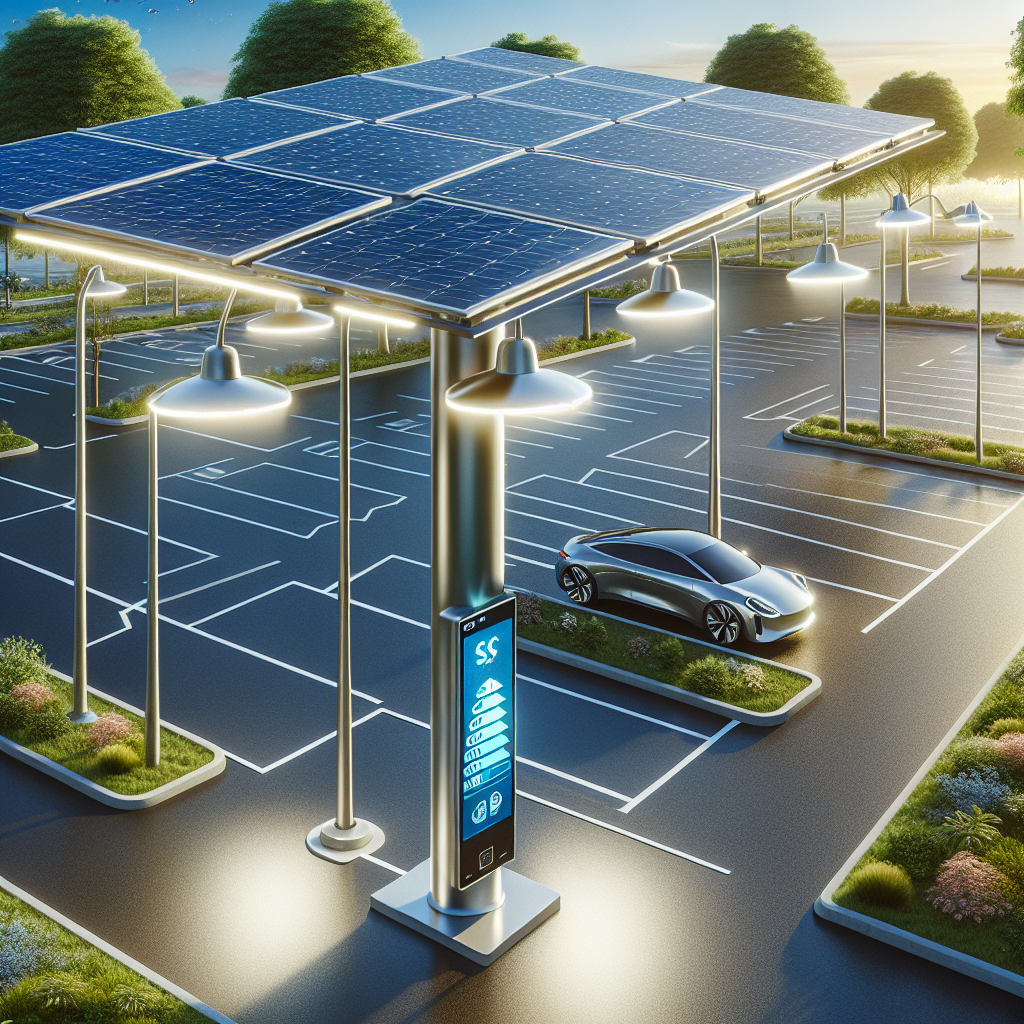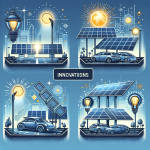Innovative Features of Solar Carpark Lights
-
Table of Contents
Innovative Features of Solar Carpark Lights
Solar carpark lights represent a significant advancement in sustainable urban infrastructure, combining cutting-edge technology with environmental stewardship. These lights harness solar energy through high-efficiency photovoltaic panels, converting sunlight into electricity to power LED luminaires. One of the standout features is their autonomous operation, equipped with smart sensors that adjust brightness based on ambient light and motion detection, ensuring optimal illumination and energy conservation. Additionally, they often include integrated battery storage systems, allowing for reliable performance even during cloudy days or nighttime. The modular design of solar carpark lights facilitates easy installation and maintenance, while their wireless connectivity enables remote monitoring and control, enhancing operational efficiency. These innovative features collectively contribute to reduced carbon footprints, lower operational costs, and improved safety and convenience in parking areas.
Advanced Motion Sensor Technology in Solar Carpark Lights
Solar carpark lights have emerged as a sustainable and efficient solution for illuminating parking areas, combining the benefits of renewable energy with advanced technological features. Among these features, advanced motion sensor technology stands out as a critical component, enhancing both functionality and energy efficiency. This article delves into the innovative aspects of motion sensor technology in solar carpark lights, highlighting its significance and impact.
To begin with, motion sensor technology in solar carpark lights is designed to detect movement within a specified range, triggering the lights to turn on or adjust their brightness accordingly. This capability is particularly advantageous in parking areas, where lighting needs fluctuate based on the presence of vehicles and pedestrians. By utilizing motion sensors, solar carpark lights can provide illumination only when necessary, thereby conserving energy and extending the lifespan of the lighting system.
One of the key innovations in this domain is the integration of passive infrared (PIR) sensors. PIR sensors detect infrared radiation emitted by warm objects, such as humans and vehicles, allowing the lights to respond promptly to movement. This type of sensor is highly effective in distinguishing between different sources of motion, reducing the likelihood of false triggers caused by non-relevant movements, such as swaying trees or small animals. Consequently, PIR sensors contribute to the reliability and efficiency of solar carpark lights.
In addition to PIR sensors, some advanced solar carpark lights incorporate microwave sensors, which operate on the principle of Doppler radar. These sensors emit microwave signals and measure the frequency shift caused by moving objects. Microwave sensors offer several advantages, including a broader detection range and the ability to penetrate non-metallic objects, such as glass and plastic. This makes them particularly useful in environments where obstacles might obstruct the line of sight, ensuring consistent and accurate motion detection.
Moreover, the integration of adaptive lighting controls further enhances the functionality of solar carpark lights. Adaptive lighting systems can adjust the brightness of the lights based on the level of activity detected by the motion sensors. For instance, the lights can operate at a lower intensity during periods of low activity and increase to full brightness when significant movement is detected. This dynamic adjustment not only optimizes energy consumption but also improves safety and visibility for users of the parking area.
Another noteworthy innovation is the incorporation of smart technology and connectivity features. Modern solar carpark lights can be equipped with wireless communication modules, enabling remote monitoring and control. Through a centralized management system, operators can receive real-time data on the status and performance of the lights, including motion detection events, battery levels, and energy consumption. This level of oversight allows for proactive maintenance and efficient management of the lighting infrastructure.
Furthermore, the use of artificial intelligence (AI) and machine learning algorithms is becoming increasingly prevalent in motion sensor technology. By analyzing patterns of movement and environmental conditions, AI-powered systems can predict and adapt to changing lighting needs more accurately. This predictive capability enhances the overall efficiency and responsiveness of solar carpark lights, ensuring optimal performance under varying circumstances.
In conclusion, advanced motion sensor technology plays a pivotal role in the effectiveness and sustainability of solar carpark lights. Through the use of PIR and microwave sensors, adaptive lighting controls, smart connectivity, and AI-driven algorithms, these systems offer a sophisticated solution for managing parking area illumination. As technology continues to evolve, the integration of these innovative features will undoubtedly contribute to the broader adoption and success of solar-powered lighting solutions.
Integration of Smart Control Systems in Solar Carpark Lighting

The integration of smart control systems in solar carpark lighting represents a significant advancement in the realm of sustainable urban infrastructure. As cities worldwide strive to reduce their carbon footprints and enhance energy efficiency, the adoption of solar-powered lighting solutions has become increasingly prevalent. However, the incorporation of smart control systems into these solar carpark lights elevates their functionality, offering a myriad of benefits that extend beyond mere illumination.
One of the most notable features of smart control systems in solar carpark lighting is their ability to optimize energy consumption. Traditional lighting systems often operate at full capacity regardless of actual need, leading to unnecessary energy expenditure. In contrast, smart control systems utilize sensors and adaptive algorithms to adjust the brightness of the lights based on real-time conditions. For instance, motion sensors can detect the presence of vehicles or pedestrians, triggering the lights to brighten only when necessary. This not only conserves energy but also extends the lifespan of the lighting fixtures, reducing maintenance costs and resource use.
Moreover, smart control systems facilitate remote monitoring and management of solar carpark lights. Through centralized control platforms, facility managers can oversee the performance of the lighting network from a single interface. This capability allows for the prompt identification and resolution of issues such as malfunctioning lights or depleted batteries. Additionally, data collected from the lighting system can be analyzed to identify patterns and trends, enabling predictive maintenance and further enhancing operational efficiency. The ability to remotely adjust lighting schedules and intensity also provides flexibility in responding to changing conditions, such as seasonal variations in daylight hours or special events that require increased illumination.
Another innovative aspect of smart control systems in solar carpark lighting is their integration with other smart city technologies. By connecting to broader urban networks, these lighting systems can contribute to a more cohesive and responsive urban environment. For example, they can be linked with traffic management systems to improve safety and efficiency in carparks. In the event of an emergency, the lights can be programmed to flash or change color, guiding first responders to the scene more quickly. Furthermore, the data generated by the lighting system can be shared with other municipal services, providing valuable insights for urban planning and development.
The environmental benefits of integrating smart control systems with solar carpark lights are also significant. By maximizing the efficiency of solar energy use, these systems help reduce reliance on non-renewable energy sources and decrease greenhouse gas emissions. The reduced need for frequent maintenance and replacement of lighting components also minimizes waste and resource consumption. Additionally, the adaptive lighting capabilities of smart control systems can mitigate light pollution, preserving the natural night-time environment and benefiting both human health and wildlife.
In conclusion, the integration of smart control systems in solar carpark lighting represents a transformative approach to urban illumination. By optimizing energy use, enabling remote management, and connecting with other smart city technologies, these systems offer a comprehensive solution that enhances efficiency, safety, and sustainability. As cities continue to evolve and embrace innovative technologies, the adoption of smart solar carpark lighting systems is poised to play a crucial role in shaping a more sustainable and resilient urban future.
Enhanced Battery Storage Solutions for Solar Carpark Lights
Enhanced battery storage solutions for solar carpark lights represent a significant advancement in the realm of sustainable urban infrastructure. As cities worldwide strive to reduce their carbon footprints and embrace renewable energy sources, solar carpark lights have emerged as a practical and eco-friendly solution. These lights harness solar energy during the day and store it in batteries for use during nighttime, ensuring that parking areas remain well-lit without relying on traditional electricity grids. The evolution of battery storage technology has played a crucial role in enhancing the efficiency and reliability of these systems.
One of the most notable innovations in this field is the development of high-capacity lithium-ion batteries. These batteries offer several advantages over traditional lead-acid batteries, including higher energy density, longer lifespan, and faster charging times. By incorporating lithium-ion batteries into solar carpark lights, manufacturers can ensure that the lights remain operational for extended periods, even during cloudy days or periods of low sunlight. This improvement not only enhances the reliability of the lighting system but also reduces maintenance costs and the frequency of battery replacements.
Moreover, advancements in battery management systems (BMS) have further optimized the performance of solar carpark lights. A sophisticated BMS can monitor and regulate the charging and discharging processes, ensuring that the batteries operate within safe parameters. This technology helps prevent overcharging, deep discharging, and overheating, which are common issues that can degrade battery performance and lifespan. By maintaining optimal battery health, a BMS contributes to the overall efficiency and longevity of solar carpark lighting systems.
In addition to lithium-ion batteries and advanced BMS, the integration of supercapacitors has also revolutionized battery storage solutions for solar carpark lights. Supercapacitors can store and release energy much more rapidly than conventional batteries, making them ideal for applications that require quick bursts of power. When used in conjunction with batteries, supercapacitors can provide immediate energy during peak demand periods, such as when multiple lights are activated simultaneously. This hybrid approach not only enhances the responsiveness of the lighting system but also reduces the strain on the batteries, thereby extending their lifespan.
Furthermore, the advent of smart grid technology has opened new avenues for optimizing battery storage solutions in solar carpark lights. By connecting these lights to a smart grid, operators can remotely monitor and control their performance in real-time. This connectivity allows for predictive maintenance, where potential issues can be identified and addressed before they lead to system failures. Additionally, smart grids enable dynamic energy management, where the stored energy can be redistributed based on demand patterns, ensuring that all areas of the carpark are adequately illuminated.
Another promising development is the use of solid-state batteries, which are currently in the research and development phase. Solid-state batteries promise even higher energy densities, faster charging times, and improved safety compared to existing battery technologies. Although they are not yet commercially available, their potential to revolutionize battery storage solutions for solar carpark lights is immense. As research progresses, it is likely that solid-state batteries will become a viable option, further enhancing the efficiency and reliability of solar-powered lighting systems.
In conclusion, enhanced battery storage solutions have significantly improved the performance and reliability of solar carpark lights. The adoption of high-capacity lithium-ion batteries, advanced battery management systems, supercapacitors, smart grid technology, and the potential future use of solid-state batteries collectively contribute to the evolution of this sustainable lighting solution. As these technologies continue to advance, solar carpark lights will undoubtedly play a crucial role in creating greener and more energy-efficient urban environments.
Read more about Solar Carpark Lights:
- Introduction to Solar Carpark Lights
- Types of Solar Carpark Lights
- Factors to Consider when Choosing Solar Carpark Lights
- Installation and Maintenance of Solar Carpark Lights
- Top Brands in the Solar Carpark Light Industry
- Innovative Features of Solar Carpark Lights
- Case Studies: Successful Implementation of Solar Carpark Lights
- Practical Applications of Solar Carpark Lights
- Future Developments in Solar Carpark Lights
- Frequently Asked Questions about Solar Carpark Lights









